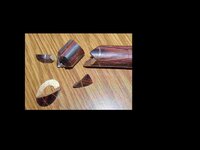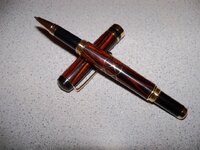You are using an out of date browser. It may not display this or other websites correctly.
You should upgrade or use an alternative browser.
You should upgrade or use an alternative browser.
A Lesson Learned
- Thread starter JTisher
- Start date
Signed-In Members Don't See This Ad
Signed-In Members Don't See This Ad
bluesman
Member
Lessons learned. Hope you find all the pieces.
gimpy
Member
After drilling, don't ever try to turn off just a little more until after the tube is glued in :frown:. Those little pieces are hard to find. On the plus side I was able to salvage it.
Joe
Just wondering why your turning the blank without the tube already inserted to begin with
JTisher
Member
I had chucked the blank into the metal lathe to drill. While it was there, I started to turn the blank to even the wood and brass, then drilled. Then came the brilliance to take one more pass with the cutter.
It went fine until the bit reached the brass, then it was all over but the looking for pieces.
After an hour I had them all then had to put the puzzle together. I'll post pics of the finished pen later
Joe
It went fine until the bit reached the brass, then it was all over but the looking for pieces.
After an hour I had them all then had to put the puzzle together. I'll post pics of the finished pen later
Joe
Sylvanite
Member
I can't speak for Joe, but I usually turn segmented blanks round prior to drilling. My segmentations typically require a centered hole for the turned pattern to come out right. I get the best drill bit registration drilling on the lathe in a collet chuck. Therefore, after gluing the segments together, I identify the middle of the design, mark the ends, and turn the blank round between centers. Then I drill.Just wondering why your turning the blank without the tube already inserted to begin with
Before rounding particularly fragile blanks, I wrap them in twine (some people use cotton bandage wrap) and saturate the string with CA glue. That helps keep everything together while I'm knocking the edges off.
After drilling, I flood the hole with thin CA glue, just to insure that the segments are well bonded at the tube surface (it helps avoid blow-outs later). Once cured, I chase the hole and then glue in the tube.
I hope that helps,
Eric
Last edited:
gimpy
Member
I can't speak for Joe, but I usually turn segmented blanks round prior to drilling. My segmentations typically require a centered hole for the turned pattern to come out right. I get the best drill bit registration drilling on the lathe in a collet chuck. Therefore, after gluing the segments together, I identify the middle of the design, mark the ends, and turn the blank round between centers. Then I drill.Just wondering why your turning the blank without the tube already inserted to begin with
Before rounding particularly fragile blanks, I wrap them in twine (some people use cotton bandage wrap) and saturate the string with CA glue. That helps keep everything together while I'm knocking the edges off.
After drilling, I flood the hole with thin CA glue, just to insure that the segments are well bonded at the tube surface (it helps avoid blow-outs later). Once cured, I chase the hole and then glue in the tube.
I hope that helps,
Eric
Ok, thanks for the explanation, never thought of it that way, I drill mine after they are squared, then drill the hole and insert the tube
JTisher
Member
bluesman
Member
Looks like a GREAT recovery. Congrads
USNR'03
Member
Very nice save!!
Hendu3270
Member
Ouch!! Yeah the glued in brass tube is all the strength of a segmented blank. Good job on being able to salvage it.
mikespenturningz
Member
It is so easy to just go a little too far. I have lost blanks doing these things too. Heart breaking but you will learn from it.
JTisher
Member
Thanks all for the compliments.
Joe
Joe


